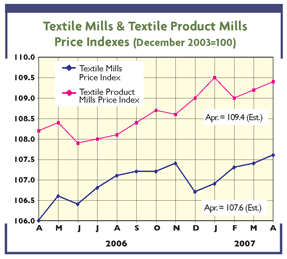T
imes change, and with its passing some old friends succumb to its various challenges. In
the textile industry, a companys viability is incumbent upon its willingness to adapt to market
challenges.
For this month’s Yarn Market, calls were made to some old spinning friends. Sadly, many of
those companies are no longer in business. Its easy to point at the current trade situation as the
cause for almost all demise within the industry, but this is not the case. Many companies fail
because they are static too set in their ways to change or too slow to recognize and respond to
changes in the market.
The good news is that those who have adapted to the changing needs of the global marketplace
are weathering the storm and emerging as strong players. This month,
TW
talked to several spinners that have responded to the changing needs of what can at times
be a rather fickle consumer market. The common thread that emerged from conversations is that those
spinners with an aggressive export strategy are positioned to thrive. Those that do not have the
resources or desire for geographic diversity seem to have a harder time.
Going Full Blast
“Were going flat out,” said one South Carolina spinner. With both ring and open-end (OE)
production going full blast, and prices remaining stable, this spinner sees no end in sight.
“Orders look good and have ever since the last part of last year. We’ve been running full-tilt
since Christmas.”
Indeed, demand seems high for ring and OE cotton, and for cotton blends both aimed primarily
at the apparel market.
“We’re exporting a whole lot of product right now,” said another ring spinner. “Were
exporting mostly to Central America and can sell it just about as fast as we make it.”
Said a low-country ring-spinner: “Exports make up a significant portion of our total business
volume, and we expect demand for cotton to continue to be strong to the next quarter.”
Prices seem relatively stable across the board.
“We’re getting about in the
mid-$0.80s for 18/1 open-end carded cotton,” said one OE spinner. Ring spun carded cotton is
going for about $1.68 for 24/1.
In value added, in addition to the current trend for recycled and organic fibers, consumers
seem to be taking a particular interest in soft-hand cottons, which is providing a particular boon
to properly equipped OE spinners.
Scraping By
“We’re scraping by at the moment,” said one specialty cotton spinner. “It is certainly not
anything to write home about, but were not quite ready to close the doors yet. There just doesnt
seem to be anything really exciting happening in our markets.”
Projecting out the rest of the year, spinners with healthy production seem confident it would
last through at least the third quarter. “Theres no end in sight,” said one. “Were selling
everything and we have no inventory.”
One OE spinner observed that the T-shirt market for his company has been slower than
anticipated, but this has been more than offset by an increase in the demand for other apparel
yarns. “The nice thing about being relatively small and flexible is the ability to quickly respond
and deliver what the customer wants,” he said. “Normally, for example, we shut down the operation
for a week at Christmastime. This past year, we were able to shut down part of our plant, but had
our OE business running throughout the holidays. This schedule has continued right on through the
year.”
Of primary concern to several spinners was the increasing cost of energy. Just when it seemed
some prices have begun to stabilize, theres been a significant increase in energy prices. ”
This might be bad news for us down
the road, if things don’t get back to normal soon,” said one spinner. “If we raise prices,
we might lose some business. If we dont raise prices, we might see our small margins get even
smaller.”
Overall, the OE and ring spinners with strong export businesses are optimistic that 2007 will
continue to be a strong year. As one spinner said, “You have to go where the customers are.” For
now, those customers are in Central America and the Caribbean.
May/June 2007

 DuPont Imaging Technologies, Wilmington, Del., introduced the DuPont Artistri 3320
DuPont Imaging Technologies, Wilmington, Del., introduced the DuPont Artistri 3320






